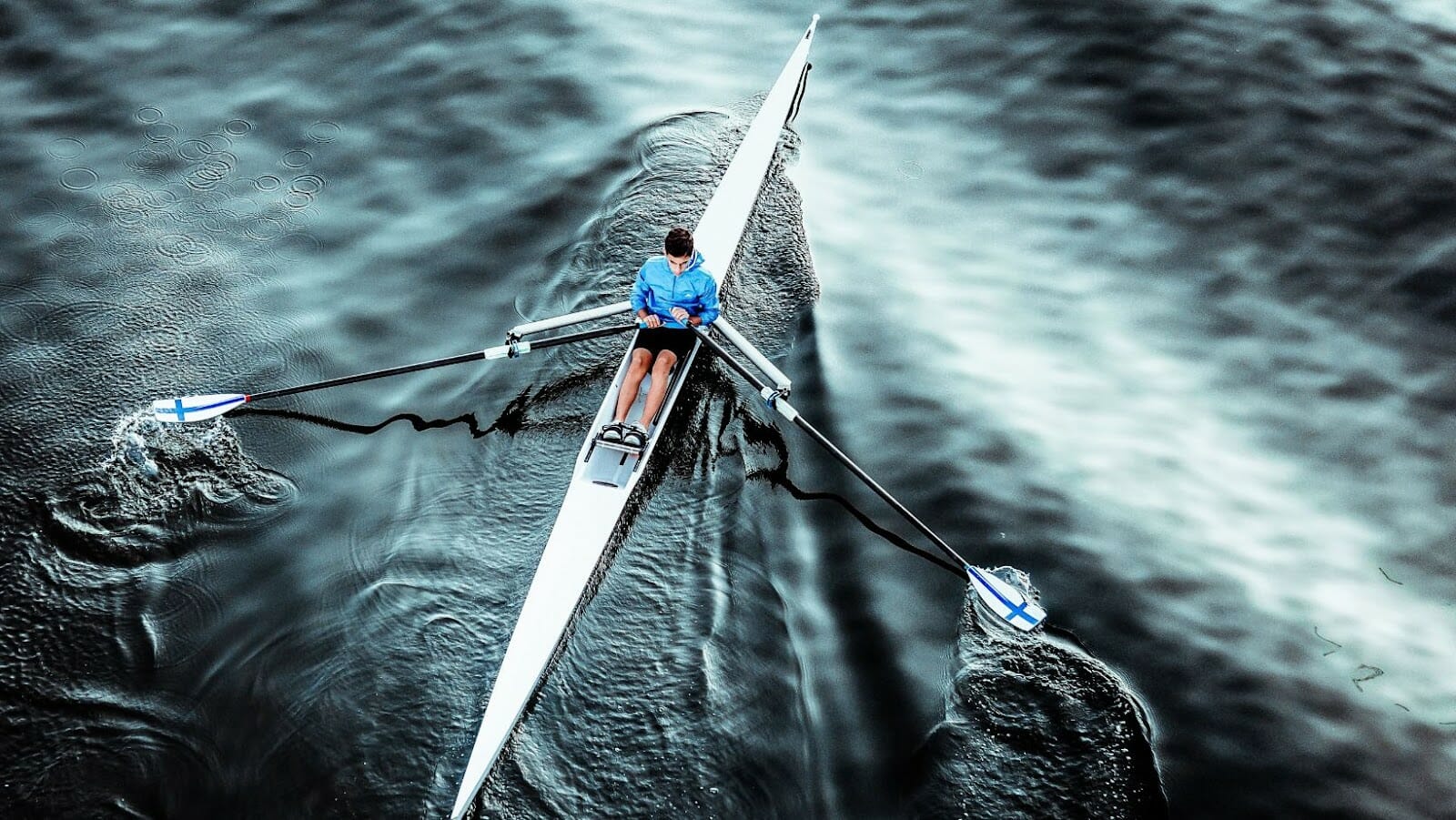Rowing and kayaking are two popular forms of aquatic exercise that offer surprising health benefits. While both activities provide a great aerobic workout for muscle toning, endurance and cardiovascular health, different features of each one make them better suited to different types of people. In this guide, we’ll analyze the pros and cons of rowing versus kayaking to help you decide which is the best choice for your fitness goals.
- Rowing is ideal for those looking to improve their cardiovascular health and tone muscles without some of the risks associated with more high impact sports like running or jogging. The sport is also beneficial for mental focus as well as physical conditioning. Most rowing machines are equipped with adjustable tension settings, allowing users to customize their workout intensity while they row.
- Kayaking is a great way to strengthen your upper body while increasing flexibility and balance — two key elements in any routine physical activity program. The repetitive motions involved with paddling require a range of motion from all parts of your arm that you don’t necessarily get in other activities like walking or jogging. Kayaks also allow for an invigorating outdoor experience that rowing does not provide.
History Of Rowing and Kayaking
Rowing and kayaking have long been enjoyed as leisurely pastimes and competitive sports. The boat-building and competitive racing styles of these activities have developed over the years to become what we now know today. In this section, we will dive into the history of rowing and kayaking, exploring their respective origins and the key differences that have shaped them.
The Origins of Rowing
Rowing is thought to have originated in ancient Egypt, and the earliest known depictions of rowing are which date back to 3000 BC in artwork located in tombs depicting men handling long oars. The earliest evidence of competitive rowing was also found during this time period, when races were held on sacred rivers as a form of worship to various deities.
In Greece and Rome, this form of exercise became popular with the upper classes and then spread to the commoners. In modern times, rowing has become a popular sport with populations all around the globe due to its cardiovascular benefits. By the 16th century, organized competitions in England had become very popular, and by 1715 these competitions began being held on fixed courses for ensuring fairness.
At this same time period in Europe, more challenges were introduced as well as different boat styles that were more efficient. By the second half of the 19th century, rowing began to be regulated by national federations forming around this sport including FISA (International Federation of Rowing Associations) which established world-wide rules in 1882. This federation continues today to set standards for equipment and regulation regarding international competition rules for both recreational and competitive rowers.
The Origins of Kayaking
Kayaking is a popular recreational activity, as well as a competitive sport, that has its roots in ancient times. According to Inuit legend, it was an Arctic spirit who came down from the sky and taught them how to hunt with kayaks and harpoons. The Inuit developed their own version of the kayak and used it extensively in both hunting and warfare between different tribes.
By the 17th century, European explorers were impressed at the speed, quality, and maneuverability of kayaks built by native tribesmen around Alaska and Siberia. This inspired historical figures like Thor Heyerdahl to experiment with their own versions of the traditional construction techniques. The availability of modern materials also allowed for modifications such as waterproof hatches and bulkheads to add additional storage space for fishing or camping gear.
Today’s kayaks come in a variety of sizes for different activities such as sea or river touring, recreational paddling, or racing conditions. Many people prefer kayaking over rowing because it allows for greater maneuverability due to less mass displacement when paddling or steering the boat – plus you don’t have to buy extra equipment like an oar! Whether you are looking to just relax on a lake or compete against your buddies on white waters – there is a suitable design perfect for you!
Rowing vs Kayaking
Rowing and Kayaking are both popular water sports, each offering unique benefits. Rowing machines and kayaks come in different shapes and sizes, so the type of boat you choose will depend on the kind of exercise you want to get out of the activity. In this article, we will look at the differences between rowing and kayaking to help you decide which one is best for you.
Physical Requirements
Rowing and kayaking, though requiring similar physical skills, demand different requirements physically of the participant. Rowing requires a great deal of strength and agility to push off from the dock and begin using the oars for propulsion. Muscles in the arms, legs, back, shoulders and abdomen must all be used to power the boat. Proper technique is paramount for avoiding injury or strain.
Kayaking, however, is more graceful in its execution. Although physical strength is still a requirement to move the paddle through the water effectively, it is also necessary to have proper technique while mastering a kayak’s special maneuverability. Kayakers need flexibility along with core stability and balance in order to control their vessel’s direction with precision. This requires more control over muscles throughout one’s body including those that control larger movements such as reaching out or extending arms behind you for support as you turn your kayak with each stroke of your paddle.
Ultimately both rowing and kayaking require physical fitness in order to propel one’s craft through water safely and efficiently; however rowing relies more heavily on muscular power whereas kayaking incorporates a greater use of fine motor skills as well stability and flexibility without compromise of efficiency or consistency in practice or performance.
Equipment
Rowing and kayaking require different types of equipment for each activity. Kayaks are typically thinner and tend to be more streamlined, allowing the paddler to move over the water’s surface with relative ease. Kayak paddles are shaped differently than those used when rowing, with curved blades that allow the user to exert a greater amount of power in their paddle stroke. On the other hand, rowing requires a wider boat and correspondingly wider oars. Rowing oars have flat blades on either end and are generally longer than those meant for kayaking, allowing the rower to get more power into each stroke of their oar as they move boats through the water.
Cost
When it comes to cost, kayaking is generally the more affordable option. A used paddle kayak can be acquired for a few hundred dollars, making it one of the most economical forms of watercraft for adventure and recreation. Rowing shells typically range from expensive recreational “club boats” to high-end competition shells, with prices often topping $10,000. Of course, there are used rowing boats available at a fraction of the cost of new models, but they aren’t always as easily obtainable as paddling kayaks.
Additionally, there are often fees associated with launching and storing a rowing shell that don’t generally apply to a kayak. Therefore, if you want to get into an aquatic sport on a budget, your best bet is probably going to be kayaking.
Benefits of Rowing and Kayaking
Rowing and kayaking are both popular water sports and are often compared to each other. Each activity has its own unique benefits that can provide different forms of exercise and recreation for people of all levels. Let’s take a look at the pros and cons of both rowing and kayaking to help you decide which one is better for you.
Cardiovascular Benefits
The two sports are both aerobic exercises, which means they contribute to increased cardiovascular fitness and improved heart health. Rowing and kayaking both rely on physical strength, endurance and flexibility. When you row or kayak, you’re strengthening your arms, legs and core muscles in addition to your cardiovascular system. This is an example of “cross-training” – different exercises that work together to improve overall fitness.
Both activities have been proven to be beneficial for overall health improvements such as lowering blood pressure, improving cholesterol levels, reducing body fat levels and increasing muscular strength. However, certain benefits are specific to either sport. Because rowing requires an intense upper body workout, it can help tone more arm technique compared to kayaking. Also because rowing strokes involve pulling the oar out of the water a few times per stroke which creates high intensity intervals so it is particularly good for improving aerobic fitness in a relatively short period of time.
On the other hand, kayaking may require more strength in the lower body since it involves applying a slow propulsion motion with your legs while pushing off from one side of the boat with your paddle while you pull toward the opposite side of the boat with your arms having alternating rotations on each side. This type of exercise leads to more overall calorie burning since a larger area of the body is working for a longer period of time as opposed to just one set muscle group like in rowing where most power is generated through the arms and back. This makes it an ideal choice if burning calories is one of your goals!
Strength Benefits
Rowing and kayaking are both excellent ways to exercise and strengthen your body. Rowing is a low impact workout that can help you build strength in both the upper and lower body. It is associated with a number of benefits, including improved heart health, muscular endurance, improved posture, and increased bone density. Additionally, rowing activates the core muscles along with the major muscle groups of the lower body while giving your arms and back an efficient workout.
Kayaking offers similar physical benefits as rowing but with a somewhat different emphasis on muscle development. Just as in rowing, kayaking works the major muscles–primarily those in the core, back, shoulders and legs–but also offers an arm workout to tone up your deltoids, biceps and triceps. Still relatively low-impact compared to other aerobic exercises like running or biking, kayaking also helps improve balance “by building strength through dynamic motion at different angles.”
In addition to these physical benefits on land-based activities such as golfing or skiing can also be improved after gaining muscular strength during regular practice of rowing or kayaking.
Mental Benefits
For many people, rowing and kayaking are activities that can help to provide both mental and physical benefits. The calming effect of the gentle movement of paddles through the water or an oar through a river can be both therapeutic and energizing. Furthermore, when practiced regularly, these activities can be used as a way to take time for oneself and to destress throughout the day. In addition to providing stress relief, participants in rowing or kayaking often experience improved moods due to the natural environment as well as its associated physical exercise. Recent research has also linked regular participation in these activities with increased resilience and focus due to the improvement in mental performance. It is also thought that these activities may boost creativity by allowing users creative freedom in how they want to approach tasks while out on the water.
In terms of social interaction, both rowing and kayaking can offer the chance for friends or family members to come together in order to enjoy some time spent together outdoors whilst reaping the rewards of getting physically active. Furthermore, rowing clubs have become increasingly popular throughout recent years which allows users an opportunity to meet new people interested in their sport should they prefer individual activity over team sports or vice versa!
Conclusion
When it comes down to a comparison of rowing vs kayaking, each option presents its own set of benefits. If overall cardiovascular conditioning and strength training is your goal, then rowing is the better choice. On the other hand, if you strive for agility and skill development with greater possibility of injury prevention, kayaking is a better choice.
Both rowing and kayaking require balance, flexibility and coordination to progress further with your training. Both activities can be enjoyed as an independent exercise or as part of a crew or team sport. Depending on your personal preference both activities offer incredible exercise benefits that can apply to any fitness level.








